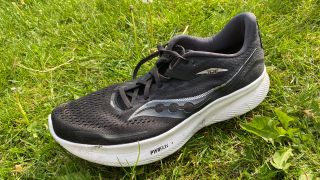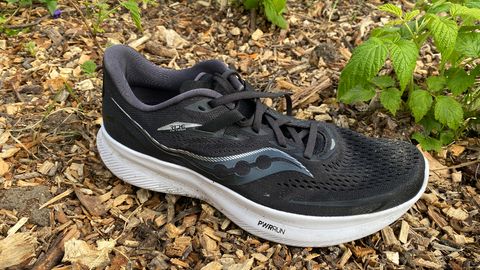Our Verdict
Saucony’s changes to the Ride 15 have made it a lighter, softer shoe than its predecessor, and it’s a great daily trainer that can handle a variety of runs. Unfortunately, the £130 price means there is better value to be found elsewhere.
For
- Lighter than Ride 14
- Versatile, comfortable ride
Against
- Better value elsewhere
- Some may prefer a softer ride
You can trust Coach
With the Ride line Saucony has always aimed to find the perfect balance of cushioning and responsiveness so the shoe works for a variety of runs. The Ride 15 does this better than in previous versions, with a drop in weight resulting improving the the ride faster runs. On performance alone it stacks up well against some of the best running shoes and deserves its title of the best daily trainer in our assessment of the best Saucony running shoes.
However, it’s in a competitive area of the shoe market and at £130 the Ride 15 costs more than equally good or better shoes, such as the Puma Velocity Nitro 2 and Nike Air Zoom Pegasus 39, making it tough to recommend over them.
Saucony Ride 15 Review: Price And Availability
The Saucony Ride 15 is available now and costs £130, a £5 increase on the Saucony Ride 14. The Ride 15 is one of the cheaper options in Saucony’s road-running range, with other shoes to consider being the £125 Kinvara 12, a lighter, low-drop trainer with a firmer ride, and the Endorphin Speed 2, which is more expensive at £155 but a shoe I rate as the best all-rounder going from any brand.

Design And Fit
The Ride 15 has an uncomplicated mesh upper, which breathes well and holds the foot securely when running at pace – or even when sodden, as I found out on one stunningly wet run. The heel and tongue are well-padded, but not to the extent of shoes like Saucony’s Triumph or the Brooks Glycerin, which are more focused on comfort. I found that the shoe had more room in the toe box than the Ride 14, but it still fitted well in my normal size.
While the midsole is made from PWRUN foam, just like the Ride 13 and 14, Saucony has tweaked the formula on the Ride 15 to make it softer and lighter. A new PWRRUN+ sock liner also increases the comfort of the shoe, which weighs 258g in my UK 9 compared with 295g for the Ride 14.
That’s a considerable drop in weight between generations of a long-running line and part of the reason is that Saucony has reduced the amount of rubber on the outsole. There is still good coverage on key areas around the heel and forefoot though, and while there is more exposed foam in the midfoot I still expect the Ride 15 to be a durable shoe – an essential characteristic for a daily trainer.
The Ride 15 has an 8mm drop with a 35mm stack height at the heel and a 27mm stack at the forefoot. The stack is higher than the 32mm heel height of the Ride 14, which also had an 8mm drop.

How I Tested This Shoe
I have run 50km in the Ride 15, starting my testing with an easy-to-steady long run covering 22km in 90 minutes. I’ve also completed a hills session in the shoe, along with easy running. I have also tested the past few generations of the Ride extensively.
Running Performance
I was not a huge fan of the Ride 13 or 14, finding them too heavy to be a versatile daily trainer and too firm to be a great easy-run option, so the changes to the Ride 15 sounded great.
My first run in the Ride 15 was the exact same as the first run I did in the Ride 14, with both shoes arriving just in time to head out for a Sunday long run. After that run I was disappointed in the Ride 15, which was noticeably lighter on the foot but didn’t feel that much softer than the Ride 14 and still didn’t feel that quick despite the lower weight.
However, the ride has noticeably improved since then, getting softer and bouncier. My experience suggests the shoe needs a short break-in period. I next used it for a hills session and the drop in weight was a noticable advantage when picking the feet up on inclines, and the softer feel came to the fore when pounding downhill.

It was my last easy run in the Ride 15 that really won me over though. Everything was against it, in that I was running late in the day, having not slept much the previous two nights, had sore legs from a strength session, and it was absolutely tipping down. I started the run grumpy and ready to get annoyed at the Ride 15 for not being soft enough for my sore legs, but it was perfect on the day, helping me to tick along nicely through the downpour and providing a more-cushioned ride than its predecessors.
The Ride 15 performs well across a range of runs and it’s one of the better daily trainers. The redesigned outsole gripped well in all conditions for me on the road, and was fine on light trails as well, with no noticeable wear so far despite it having more exposed foam than the 14.
Is The Saucony Ride 15 Worth It?
There isn’t much to fault about the Ride 15. It’s an improvement on its predecessor and while it’s not a great shoe for all-out speedwork not many daily trainers are. It will cover off the majority of your training nicely.
For runners with a shoe rotation, it sits neatly alongside a speedier racing shoe and perhaps a more-cushioned option for easy runs if you want something very soft for those. One-shoe runners will find the Ride 15 covers all the bases well.

The problem is the price. At £130 it’s not expensive for a running shoe (these days, anyway), but in this category of daily trainers it costs more than several great options. The Puma Velocity Nitro 2 is softer, bouncier and more fun and costs £100. The Nike Pegasus 39 is similar to the Ride 15 at £110, and while it is heavier that’s largely down to a thicker outsole that improves durability and grip. There's also the Reebok Floatride Energy 4, which matched up well to the Ride 15 in my testing and costs £75.
If you pick up the Ride 15 I don’t think you’ll be disappointed, but there is better value elsewhere, with the Velocity Nitro 2 being the standout in my view because of the more enjoyable, bouncy ride.

Nick Harris-Fry is a journalist who has been covering health and fitness since 2015. Nick is an avid runner, covering 70-110km a week, which gives him ample opportunity to test a wide range of running shoes and running gear. He is also the chief tester for fitness trackers and running watches, treadmills and exercise bikes, and workout headphones.

This Expert PT Recommends Kettlebell Training For Strength, Power And Cardio Gains—And These Are The Six Exercises To Master First

I’ve Run The London Marathon Six Times—Here Are Four Ways To Set-Up Your Garmin Watch For A Better Race

Forget Crunches, This Exercise Is A Better Way To Build A Strong Core
